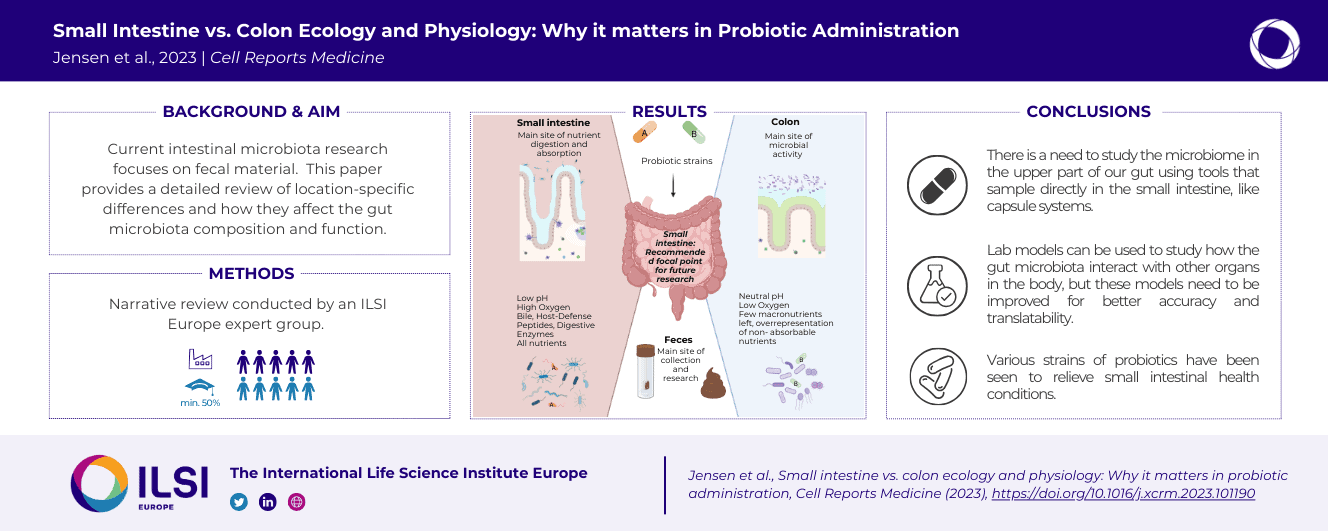
BRUSSELS, BELGIUM - Gut microbiota research has traditionally focused on faecal samples, which represent the luminal content of the distal large intestine. However, recent research suggests that understanding the differences between the small and large intestine is critical to better leverage the immense potential of human gut microbiota modulation through probiotic administration.
A new ILSI Europe publication, entitled "Small intestine vs. colon ecology and physiology: Why it matters in probiotic administration," provides a detailed review of the physiological and anatomical differences between the small intestine and the colon and their effects on gut microbiota composition, function, and plasticity. The authors highlight the importance of understanding these differences in host-microbe interactions and how probiotic administration may transform these interactions at defined locations.
 The work emphasizes the abundant immune cell populations in the small intestine, combined with limited mucus secretion and looser junctions, which allow for efficient fluid and nutrient absorption. These factors result in intimate host-microbe interactions, despite rapid transit time. By dissecting the key differences in both ecology and physiology between the small and large intestine, the authors highlight the potential of gut microbiota manipulation, including probiotic administration, to transform host-microbe interactions at defined locations.
The work emphasizes the abundant immune cell populations in the small intestine, combined with limited mucus secretion and looser junctions, which allow for efficient fluid and nutrient absorption. These factors result in intimate host-microbe interactions, despite rapid transit time. By dissecting the key differences in both ecology and physiology between the small and large intestine, the authors highlight the potential of gut microbiota manipulation, including probiotic administration, to transform host-microbe interactions at defined locations.
The findings of this publication have important implications for the development of novel probiotic therapies, new research techniques and models to better understand the interaction between the gut microbiota and the host.
Expert group member Pieter Van den Abbeele, CSO of Cryptobiotix, commented: “The small intestinal microbiome is a promising new avenue to unravel additional mechanisms of action of probiotics. Having spent decades developing and enhancing preclinical research models, we recognise the pivotal role of the consolidation effort led by ILSI Europe. It not only guides the future development of gut microbiome models but also sharpens our focus on uncovering mechanisms of action within the gut ecosystem.”
Chair of ILSI Europe’s Probiotics Task Force Arthur Ouwehand from IFF stated: “It is often assumed the small intestine is an important site of action for probiotics, but we know too little about it and its microbiota. What are the implications of this lack of understanding? This is what stimulated the ILSI Europe Probiotics Task Force to ask a group of experts from industry and academia to work on the topic and identify the knowledge gaps. We hope to make academic and industry R&D aware of them and stimulate research to fill them. This hopefully will lead to both an expansion of knowledge and better probiotic choices.”
Lead author and expert group chair Benjamin Anderschou Holbech Jensen from University of Copenhagen added: “The development of affordable sequencing techniques, advanced culturing methods, and multiomic strategies has propelled the research on host-microbe interactions into new dimensions. Still, while there is a substantial and needed push to move from association studies to mechanistic causality, our current knowledge remains limited to fecal samples and colon biopsies. This is a paradox, as many probiotics are targeting the small intestine by e.g., affecting nutrient absorption. But perhaps even more importantly, the small intestine is characterized by highly dynamic microenvironments where the loosely adherent mucus layer exposes the luminal surface to intricate host-microbe interactions. Thus, to leverage the full potential of microbiota modulation, we suggest putting microbial dynamics and host-microbe-interactions in the small intestine, rather than in colon, as a focal point for future research.”
The authors believe that a better understanding and appreciation of the differences between the small and large intestine will provide critical information on how to manipulate the gut microbiota to improve human health.
For more information on this study, please refer to the original publication: “Jensen et al., Small intestine vs. colon ecology and physiology: Why it matters in probiotic administration, Cell Reports Medicine (2023), https://doi.org/10.1016/j.xcrm.2023.101190 ” which is now available online.
About the authors
The experts who contributed to this work—Benjamin Anderschou Holbech Jensen, Marc Heyndrickx, Daisy Jonkers, Alan Mackie, Sam Millet, Malwina Naghibi, Simone Isling Pærregaard, Bruno Pot, Delphine Saulnier, Christian Sina, Luc Sterkman, Pieter Van den Abbeele, Naomi Venlet, Erwin Zoetendal, Arthur Ouwehand—are among the leading scientists in the field from both industry and academia. This representation across multiple sectors ensures objective and reliable content.
This work was coordinated by the ILSI Europe Probiotics Task Force.
the ILSI Europe Probiotics Task Force.
For more information about the Task Force, please visit: https://ilsi.eu/scientific-activities/nutrition/probiotics/
Contact
- For questions regarding ILSI Europe or the Probiotic and Prebiotic Task Forces, please contact Naomi Venlet at nvenlet@ilsieurope.be
- For questions regarding the paper, please contact Benjamin Anderschou Holbech Jensen at or Naomi Venlet at nvenlet@ilsieurope.be
ILSI Europe is the European branch of the International Life Sciences Institute (ILSI), a global, non-profit federation with 10 entities around the world. Our mission is to develop, communicate and disseminate science-based guidance to tackle food, public health, and sustainability challenges. We facilitate collaboration and consensus-building between academic, industry and public service experts. Learn more at ilsi.eu
